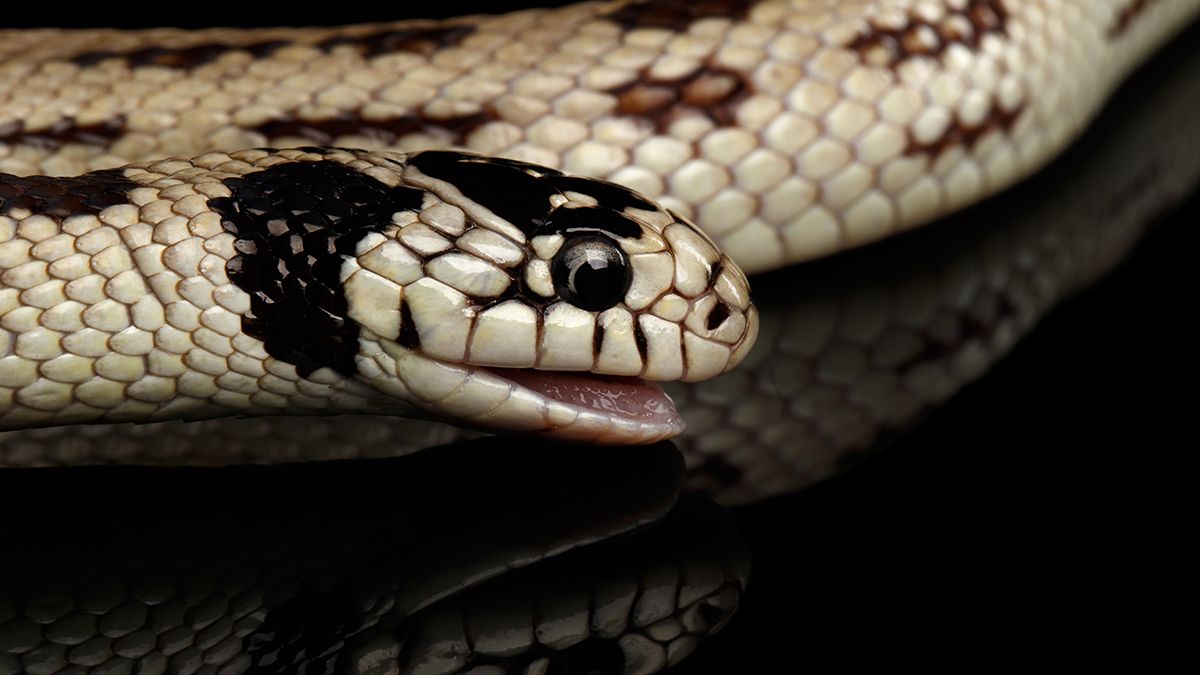
Species Overview
- Common Names: Common Kingsnake
- Scientific Name: Lampropeltis spp.
- Distribution: Found throughout the southern United States west into California
- Adult Size: 3’-6’
- Life Expectancy: 15-20 years+
Kingsnakes are among the most beautiful snakes in the world and have been popular pets in the reptile hobby since the beginning. Many different types of kingsnakes are found in North America, and care requirements are very similar for all of them. Kingsnakes were given their name because they are the “King” of snakes in America. They are considered “Kings” because they regularly eat other species of snakes in the wild, including rattlesnakes.
About King Snakes
King Snake Pet Care: Habitat Set-Up
Habitat
- Hatchlings to juvenile kingsnakes (under 18”) can be housed in a 10-gallon terrarium.
- Adult kingsnakes will need at least a 20-30 gallon terrarium. We recommend keeping snakes in an enclosure that is no shorter than half the length of the snake.
- A secure, lockable sliding-screen lid is essential for safely housing these snakes.
- Zoo Med’s ReptiHabitat™ 20 and 40-gallon terrariums are an excellent choice for kingsnakes.
- A Repti-Shelter™, Habba Hut™, or Cork Bark will provide a secure hiding place to help reduce stress.
Heating
- Daytime Terrarium Temperature 75-80° F
- Basking Temperature 85-88° F
- Nighttime Terrarium Temperature 72-75° F
- Place a heat lamp and an under-tank heater on one side of the terrarium to create a thermal gradient in your snake enclosure. Zoo Med’s Daylight Blue Reptile Bulb is an excellent choice for heating snake enclosures. Placing the heating elements on one side of the cage will naturally provide the proper thermal gradient.
- Any of Zoo Med’s thermometers will help you closely monitor terrarium temperatures.
- Keep all hides, such as a Repti-Shelther™ or Habba Hut™, on the cool end of the enclosure.
- A ReptiTherm® Under Tank Heater or ReptCare™ Rock Heater is essential to provide belly heat to your snake while it digests a meal.
Lighting
- Snakes typically do not require UVB to meet their vitamin D requirements. However, many snakes receive UVB and sunlight in their natural habitat, and there is new evidence that they benefit from UVB lighting in captivity.
- Zoo Med’s NatureSun® or ReptiSun® fluorescent lamps can be used to illuminate your terrarium and create a natural day/night photoperiod.
Substrates
- Kingsnakes will do best on Zoo Med’s Aspen Snake Bedding™, Forest Floor™ cypress mulch, or ReptiBark®. We recommend a substrate layer of 2-3” in depth.
- Provide moistened New Zealand Sphagnum Moss in a Repti Shelter™ to create a humidity chamber. This chamber will help your snake shed its skin as it grows.
- Zoo Med’s Eco Carpet™ can be used as a safe, environmentally friendly, and easy-to-clean substrate.
King Snake Pet Care: Temperament
- California kingsnakes have a calm temperament. They are not aggressive unless they feel threatened, and they also adapt well to captivity. Because of their quiet character and ease of adaptability, California kingsnakes make great pets. They are not dangerous and are very small, which makes them much easier to maintain and handle.
King Snake Pet Care: Diet and Nutrition
- Kingsnakes can be fed mice and small rats exclusively throughout their lives. Rodents provide snakes with the calcium and vitamins they need, so additional supplementation is not required.
- Always have fresh water available. ReptiSafe® Water Conditioner is an excellent choice for removing Chlorine and Chloramines from tap water.
- Zoo Med’s Corner Bowls are an excellent choice of water bowls for all snakes.
- When choosing a properly sized food item for your snake, select a mouse or rat that is the same size or slightly bigger than the snake’s girth.
- Hatchings: Will eat one pinkie mouse per week.
- Juveniles: Will eat one hopper-adult mouse per week.
- Adults: Will eat 1-2 adult mice per week. Unusually large Kingsnakes will eat one appropriately sized rat per week.
Pet Safety
- Use caution when handling pets, and remember they may bite or scratch (especially when stressed).
- Supervise children around pets.
- ALL ANIMALS can potentially carry viral, bacterial, fungal, and parasitic diseases contagious to humans.
- Thoroughly wash your hands with warm, soapy water before and after contact with any pet or its habitat.
- Adults should assist children with handwashing after contact with a pet, its habitat, or aquarium water.
Related Searches
Reptile Care